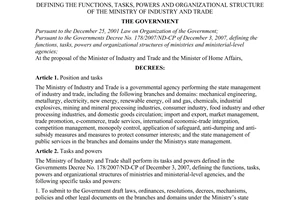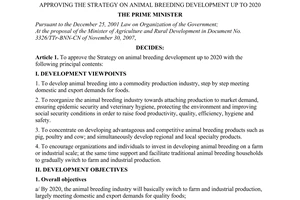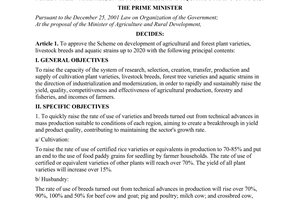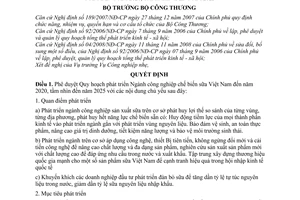Nội dung toàn văn Decision 3399/QD-BCT approving plan development milk processing industry Vietnam
|
THE MINISTRY OF
INDUSTRY AND TRADE |
THE SOCIALIST
REPUBLIC OF VIETNAM |
|
No. 3399/QD-BCT |
Hanoi, June 28, 2010 |
DECISION
APPROVING THE PLAN FOR DEVELOPMENT OF THE MILK PROCESSING INDUSTRY OF VIETNAM BY 2020 WITH VISION TO 2025
THE MINISTER OF INDUSTRY AND TRADE
Pursuant to the Government’s Decree No. 189/2007/ND-CP dated December 27, 2007 on the functions, duties, powers and organization structure of the Ministry of Industry and Trade;
Pursuant to the Government’s Decree No. 92/2006/ND-CP dated September 7, 2006 on formulation, approval and administration of the general socio-economic development plan;
Pursuant to the Government’s Decree No. 04/2008/ND-CP dated November 11, 2008 on revision of certain articles of the Government's Decree No. 92/2006/ND-CP dated September 7, 2006 on formulation, approval and administration of the general socio-economic development plan;
After considering the request of the Director of the Light Industry Department,
HEREBY DECIDES
Article 1. to approve the plan for development of the milk processing industry of Vietnam by 2020 with vision to 2025 which has the following main contents:
1. Development viewpoints
a) Develop the milk manufacturing industry on the basis of capitalising on the comparative advantage of each region or locality, and make most use of available processing capacity by mobilising potential resources of economic sectors to engage in sectoral development associated with development of raw material zones. Meet statutory requirements concerning food hygiene and safety, improvement of nutritional value, less energy consumption and ecological environment protection.
b) Develop the milk manufacturing industry on the basis of applying advanced technologies and equipment, incessantly innovate and reform applied technologies to improve quality and diversify manufactured products, and conduct researches into manufacturing of new high-quality products to meet domestic and exporting demands. Concentrate on building a strong national trademark for certain milk products of Vietnam to promote their effective competiveness in the context of international integration
c) Encourage enterprises to invest in an increase in size of the herd of dairy cows which entails a gradual increase in percentage of self-supply of domestic raw materials, and move towards a gradual decrease in the imported volume of raw dairy materials.
2. Development objectives
a) General objectives: Gradually attain the objective of creating a sustainable milk processing industry in which the production activities from raw material processing and finished product manufacturing must be modern and consistent, and which may have competitiveness to proactively integrate with that of the region and globe as well as meet increasing social and export demands.
b) Specific objectives:
- In 2015, it is expected that 1.9 billion of litres of milk converted into fresh milk will be manufactured and an average amount of 21 litres of milk per capita will be consumed nationwide each year. Domestically-manufactured fresh milk will reach 660 litres meeting 35% of the consumption demand and the export turnover will reach USD 90-100 million.
- In 2020, it is expected that 2.6 billion of litres of milk converted into fresh milk will be manufactured and an average amount of 27 litres of milk per capital will be consumed nationwide each year. Domestically-manufactured fresh milk will reach 1 billion of litres meeting 38% of the consumption demand and the export turnover will reach USD 120 – 130 million.
- In 2025, it is expected that 3.4 billion of litres of milk converted into fresh milk will be manufactured and an average amount of 34 litres of milk per capital will be consumed nationwide each year. Domestically-manufactured fresh milk will reach 1.4 billion of litres meeting 40% of the consumption demand and the export turnover will reach USD 150 – 200 million.
3. Development orientation
a) Develop the milk processing industry in a modern and sustainable manner to satisfy requirements that production is cleaner, wastes are more completely treated, and food hygiene and safety are ensured.
b) Continue to invest in establishing new facilities and expanding existing facilities in order to meet domestic consumption and export demands. Concentrate on increasing capacity to manufacture pasteurised and sterilized milk, powdered milk and yogurts. Newly-established factories must be powered by advanced and cutting-edge technologies to manufacture products that meet high quality standards and are diverse in terms of product categories and designs.
c) Develop the milk processing industry with the aim of gradually boosting up use of domestic fresh milk and reducing the proportion of imported raw powdered milk. Develop the milk processing industry tightly associated with development of size of the domestic herd of dairy cows. Milk processing facilities must design a particular program for investing in development of the herd of dairy cows. Arrange the site used for construction of milk factories associated with milk product trading centers and concentrated dairy cow farming zones.
4. The plan for development of milk products and the plan for distribution of production capacity by territorial regions
a) Product plan (see the Appendix 1 attached herein for more details).
- Manufacturing of pasteurised and sterilized milk:
It is expected that production output of pasteurized and sterilized milk will reach 480, 780, 1,150 and 1,500 million of litres in 2010, 2015, 2020 and 2025 respectively.
- Manufacturing of sweetened condensed milk:
The production output of sweetened condensed milk is expected to reach 377, 400, 410 and 420 million of boxes in 2010, 2015, 2020 and 2025 respectively.
- Manufacturing of yogurt:
It is expected that the production output of yogurt will reach 86, 120, 160 and 210 million of litres in 2010, 2015, 2020 and 2025 respectively.
- Manufacturing of powdered milk:
The production output of powdered milk is expected to reach 47, 80, 120 and 170 thousands of tons in 2010, 2015, 2020 and 2025 respectively.
b) The plan for distribution of production capacity by territorial regions
The plan for distribution of capacity to manufacture product lines nationwide will be determined by 6 territorial zones (see the Appendix 2 attached herein).
Distribution of capacity to manufacture product lines by territorial zones will help to create balanced development between zones depending on the demands for milk products and potentials for increasing size of the herd of dairy cows, and satisfy the Government’s demands for socio-economic development over time periods.
5. Demand of investment funds
- a) Total estimated demand for investment funds used in the period 2011-2015, 2016-2020 and 2021-2025 is VND 4,240 billion, VND 5,230 billion and VND 6,060 billion (see details at the Appendix 3 attached herein).
Investment funds will be sourced from all economic sectors in the society, loans offered by foreign and domestic banks, funds derived from issuance of equities and corporate bonds and Government preferential loans.
6. System of plan implementation solutions and policies
a) Market
- Intensify inspection of quality of raw materials and milk products which are domestically manufactured, imported and sold on the domestic market in order to prevent contrabands and products which have low quality and fail to meet quality requirements as referred to in stipulated food hygiene and safety standards. Make a public notice of the results achieved from quality inspection of milk products and impose strict sanctions for acts of violation.
- Hold annual domestic trade fairs in order to create opportunities for enterprises to participate in product promotion and advertisement activities. Give support to enterprises participating in trade fairs for product promotion held abroad according to the national trade promotion program to serve the purpose of expanding export markets.
- Design the national school milk program in order to enable preschoolers and primary school students to have access to milk as a significant contribution to improving physical and mental health of children.
- Stimulate public awareness enhancement activities in order for the public to be well informed of quality of milk, provide guidance for consumers to make their correct judgements on quality and helpful effects of milk, and decide on which products should be used.
- Encourage enterprises to establish their business and market expansion strategies. Build and multiply the network of agencies for distribution and consumption of products, and promote the roles of branches in order to enhance their proactivity in business operations.
- Encourage enterprises to detect fraudulent acts and unhealthy competitions on the market and collaborate with state regulatory authorities in outlining controlling measures.
b) Product brand building
- Enterprises should draw up the plan or strategy for development of their own brands with particular attention paid to traditional values and habits of Vietnamese consumers.
- With regard to Vietnamese milk products which have already gained their good reputation and proved their reliability in the domestic market, there should be a long-term development strategy in place on the basis of expanding production for the purpose of upholding and developing market shares, boosting up product quality, incessantly innovating product designs, diversifying product categories, strengthening and developing the system for consumption of products which ensures reliability, convenience and prestige in customers’ eyes.
- The Government must intensify monitoring of protection of trademarks, brands, designs and packages of products, and struggle against contrabands and low-quality products in order to conserve interests of both enterprises and consumers.
- On an annual basis, the Ministry of Industry and Trade will select and announce the title of best Vietnamese brands according to a consistent set of criteria to encourage enterprises to improve quality of their products and build their own trademarks.
c) Investment
- Encourage enterprises to invest in expansion of production associated with innovation of technology and equipment, and apply energy-saving solutions.
- Strictly control new investment projects to restrict utilization of equipment powered by outdated technologies that may lead to failure to meet food hygiene and safety requirements, and refuse to license projects of which construction of waste treatment systems meeting regulations on environmental protection is not included.
d) Sectoral management
- Release quality standards and technical regulations on milk products in conformity with international conventions as the basis for monitoring and inspection activities.
- Promote close inspection of compliance of domestic manufacturers with regulatory requirements concerning quality, food hygiene, safety and environment health. Force enterprises to announce and register their product quality. Check and inspect quality of importing and exporting products in conformance to Vietnamese standards and international laws.
- Encourage involvement of economic sectors in establishing testing laboratories for inspection of milk quality to serve as a counterbalance to those of milk processing factories and provide more options for dairy cow raisers.
- Perfect legal documents on management of milk price and ensure that interests of manufacturers, distributors and consumers are shared in a harmonious manner.
- Complete strict supervisory and regulatory policies under which regulators carry out strict supervision and administration of acts of unhealthy competition on the milk market, especially any advertising that may mislead consumers.
- Place more emphasis on the roles of the Vietnam Dairy Association in sectoral management in order to protect legal interests of enterprises and consumers.
dd) Scientific research and technology transfer
- The Government shall encourage enterprises to invest in scientific researches and apply advanced technologies to milk production activities, buy innovative technologies and equipment from developed countries and receive technologies transferred from the world’s top companies. Costs of scientific research shall be recorded into production costs.
- Encourage enterprises to, in the form of joint venture or affiliation, carry out technology transfers to manufacture domestic equipment that meets modern technical requirements. Encourage them to use domestically-invented equipment that has the same quality as that of imported equipment in investment projects.
- The Government shall encourage research into and transfer of technologies for manufacturing of high-quality packages, milk processing supportives, additives and microelements in order to ensure food quality, hygiene and safety which are applied in the milk industry.
- Enhance research competence of certain institutes in order for them to be able to concentrate on research into scientific and technological issues concerning processing and storage of milk as well as food hygiene and safety.
e) Development of production of raw materials to be used in the milk processing industry
- Build intensive dairy cow farming zones invested in by enterprises or make investment according to the model in which large enterprises keep control of supplying dairy cow breeds and technical services as well as consuming products, and intensive dairy cow raising households raise dairy cows and extract milk.
- Form aid funds for development raw material concentrations set aside from mobilised funds or finances of domestic and overseas enterprises, entities or individuals.
- Intensive dairy cow farming enterprises and households shall be entitled to incentive policies, referred to in the Prime Minister’s Decision No. 10/2008/QD-TTg dated January 16, 2008 on approval of the animal farming development strategy by 2020 and the Decision No. 2194/QD-TTg dated December 25, 2009 on approval of the Proposal for development of agricultural, forestry varieties, livestock and fish breeds by 2020.
g) Human resource training
- Enterprises shall set up the program and plan for training or re-training of officers and skilled workers. Training must adhere to the guideline under which workforce must be trained not only to undertake as many different work duties as possible meet current demands, but also to be qualified as specialists or leading experts in each industry to meet future demands of this industry. Combination of the domestic and foreign, formal and informal, or short-term and long-term, training models is required.
- Promote training competency of universities, colleges and vocational schools in order to train science officers, general administration officers and technicians who become qualified and meet increasing demands for workforce in the dairy industry.
h) Finance and credit
- The Government must apply policies on input VAT deductions to enterprises or entities directly purchasing freshmilk from farmer's households in order to encourage enterprises purchasing domestic raw milk materials to be used for processing activities (currently, farmers do not have financial invoices required to sell their raw milk materials).
- Offer investment and development loans extended by the Government to invest in dairy cow breed development projects; to build and expand dairy cow farming, milk collection and industrial milk processing facilities.
Article 2. Implementation
1. The Ministry of Industry and Trade shall undertake or collaborate with relevant Ministries, sectoral departments and People’s Committees of centrally-affiliated cities and/or provinces in provision of sectoral development direction according to this Plan.
2. The Ministry of Agriculture and Rural Development shall direct relevant local entities to collaborate with enterprises in formulating and executing the plan for development of intensive dairy cow farming industry within their jurisdiction.
3. Ministries and sectoral departments, including Planning and Investment, Finance, Science and Technology, Natural Resources and Environment, Health, Culture, Information and Telecommunications, and Education and Training, shall, within their jurisdiction, undertake and collaborate with the Ministry of Industry and Trade in:
- issuance of quality standards, production regulations applied to mil products and cooperative with local jurisdictions to inspect product quality, ensure that standards concerning food safety, environmental sanitation and laws on industrial property rights, equal competition, and protection of consumers’ rights and benefits, must be obeyed.
- adjustment to tax levied on imported raw materials and milk products in order to stimulate domestic milk production.
- representation to the Government to establish the National school milk program.
4. The People’s Committees of centrally-affiliated cities and provinces shall actualize the Plan for development of the milk industry of Vietnam within their jurisdictions; join with Ministries and sectoral departments to inspect and supervise implementation of this Plan to ensure consistency and alignment with the General Plan for socio-economic development in these jurisdictions.
5. The Vietnam Dairy Association shall liaise with the Ministry of Industry and Trade and local jurisdictions to make known to the public and disseminate this Plan; guide its member enterprises to comply with this plan and other laws and regulations.
Article 3. This Decision shall enter into force from the signature date.
Article 4. Ministers, Heads of Ministry-level agencies, Heads of Government bodies, and Presidents of People’s Committees of centrally-affiliated cities and/or provinces, shall be responsible for enforcing this Decision./.
|
|
THE MINISTER |
APPENDIX 1
PLAN FOR DEVELOPMENT OF MANUFACTURING OF DAIRY PRODUCTS
(Appended to the Decision No. 3399/QD-BCT dated June 28, 2010 of the
Minister of Industry and Trade)
|
|
Indicator |
Unit of measurement |
2010 |
2015 |
2020 |
2025 |
|
1 |
Pasteurized and/or sterilized milk |
Million litres |
480 |
780 |
1150 |
1500 |
|
2 |
Sweetened condensed milk (carton pack) |
Million litres |
377 |
400 |
410 |
420 |
|
3 |
Yogurt |
Million litres |
86 |
120 |
160 |
210 |
|
4 |
Powdered milk of various kinds |
1000 tons |
47 |
80 |
120 |
170 |
|
5 |
Butter |
Ton |
6 |
8 |
10 |
13 |
|
6 |
Cheese |
Ton |
72 |
84 |
97 |
107 |
|
7 |
Cream of various kinds |
1000 tons |
13 |
20 |
27 |
38 |
|
8 |
Other dairy products (nutritional powder) |
1000 tons |
22 |
44 |
65 |
83 |
|
|
Total production, converted into freshmilk production |
Million litres |
1300 |
1900 |
2600 |
3400 |
|
|
Population |
Million persons |
86.70 |
91.13 |
95.30 |
99.18 |
|
|
Per capita |
Litre/person |
15 |
21 |
27 |
34 |
|
|
Average growth |
|
2006-2010 |
2011-2015 |
2016-2020 |
2021-2025 |
|
|
Pasteurized and/or sterilized milk |
%/year |
18.4 |
10.0 |
8.0 |
6.0 |
|
|
Sweetened condensed milk (carton pack) |
%/year |
0.7 |
1.0 |
0.8 |
0.5 |
|
|
Yogurt |
%/year |
7.2 |
7.0 |
6.0 |
5.0 |
|
|
Powdered milk of various kinds |
%/year |
-1.3 |
11.0 |
8.5 |
7.0 |
|
|
Butter |
%/year |
-0.3 |
5.0 |
5.0 |
5.0 |
|
|
Cheese |
%/year |
-2.1 |
3.0 |
3.0 |
2.0 |
|
|
Cream of various kinds |
%/year |
8.8 |
8.0 |
7.0 |
7.0 |
|
|
Other dairy products (nutritional powder) |
%/year |
67.3 |
15.0 |
8.0 |
5.0 |
|
|
Total production, converted into freshmilk production |
%/year |
5.3 |
7.8 |
6.7 |
5.5 |
|
|
Per capita |
%/year |
1.1 |
1.0 |
0.9 |
0.8 |
APPENDIX 2
PLAN FOR DISTRIBUTION OF CAPACITY FOR PROCESSING MILK
PRODUCTS BY 6 TERRITORIAL REGIONS
(Appended to the Decision No. 3399/QD-BCT dated June 28, 2010 of the
Minister of Industry and Trade)
|
Region |
2010 |
2015 |
2020 |
2025 |
|
Production capacity of pasteurized and sterilized milk products by regions, million litres/year |
||||
|
Northern midland and mountainous areas |
69 |
98 |
98 |
128 |
|
Red river delta |
237 |
288 |
378 |
619 |
|
Central coastal area |
86 |
86 |
136 |
186 |
|
Central highlands |
|
|
|
50 |
|
South east |
367 |
567 |
767 |
817 |
|
Mekong river delta |
19 |
19 |
69 |
119 |
|
Total |
778 |
1,059 |
1,449 |
1,920 |
|
Production capacity of yogurt products by regions, million litres/year |
||||
|
Northern midland and mountainous areas |
2.0 |
2 |
2 |
2 |
|
Red river delta |
60.0 |
60 |
60 |
105 |
|
Central coastal area |
19.2 |
19 |
19 |
19 |
|
South east |
59.0 |
59 |
109 |
159 |
|
Mekong river delta |
10.6 |
11 |
11 |
11 |
|
Total |
150.8 |
151 |
201 |
296 |
|
Production capacity of powdered milk by regions, million tonnes/year |
||||
|
Red river delta |
12.6 |
13 |
13 |
60 |
|
South east |
88.9 |
89 |
134 |
149 |
|
Total |
101.5 |
102 |
147 |
209 |
|
Production capacity of milk converted into freshmilk by regions, million litres/year |
||||
|
Northern midland and mountainous areas |
71 |
100 |
100 |
130 |
|
Red river delta |
452 |
503 |
593 |
1,225 |
|
Central coastal area |
176 |
176 |
226 |
276 |
|
Central highlands |
|
|
|
50 |
|
South east |
1,644 |
1,844 |
2,422 |
2,624 |
|
Mekong river delta |
113 |
113 |
163 |
213 |
|
Total |
2,456 |
2,736 |
3,504 |
4,518 |
APPENDIX 3
DEMAND OF FUNDS FOR MILK PROCESSING INDUSTRY INVESTMENT
AND DEVELOPMENT
(Appended to the Decision No. 3399/QD-BCT dated June 28, 2010 of the
Minister of Industry and Trade)
Unit: billion dong
|
No. |
Item |
2010-2015 |
2016-2020 |
2021-2025 |
|
1 |
Fund for the processing industry |
1,190 |
1,280 |
1,500 |
|
2 |
Fund for development of raw materials |
2,150 |
3,130 |
3,490 |
|
3 |
Fund for development of auxiliary industries |
720 |
630 |
850 |
|
4 |
Fund for construction of milk procurement stations |
180 |
190 |
220 |
|
|
TOTAL FUND DEMAND OF THE WHOLE INDUSTRY |
4,240 |
5,230 |
6,060 |
------------------------------------------------------------------------------------------------------
This translation is made by LawSoft and
for reference purposes only. Its copyright is owned by LawSoft
and protected under Clause 2, Article 14 of the Law on Intellectual Property.Your comments are always welcomed



